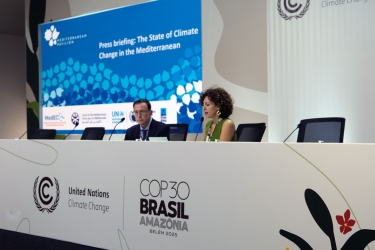Climate-Smart Forestry

A new science-policy report from EFI demonstrates how different Climate-Smart Forestry measures in three European regions can enhance the role of forests in tackling climate change.
Forests and the forest sector play a significant role in climate change mitigation through the capture of CO2 in forests and wood products, as well as through material and energy substitution. Climate-Smart Forestry (CSF) is a targeted approach or strategy to increase the climate benefits from forests and the forest sector, in a way that creates synergies with other needs related to forests.
The approach builds on three pillars:
- reducing and/or removing greenhouse gas emissions to mitigate climate change
- adapting forest management to build resilient forests
- active forest management aiming to sustainably increase productivity and provide all benefits that forests can provide.
The From Science to Policy report demonstrates how concrete CSF measures could impact CO2 removals in three different case study regions in Europe: Spain, Czech Republic and Republic of Ireland. Each region has different characteristics in its forests and forest sector, and faces different challenges.
Scenario projections for parts of Spain (1.6 million ha), the Czech Republic (2.7 million ha) and the Republic of Ireland (0.8 million ha) provided insights in the carbon balance of the forest ecosystems, and harvested wood products material and energy substitution effects.
For the three case studies, an average overall net additional mitigation effect of 7.1 Mt CO2/yr after 50 years is achieved by implementing CSF measures. This can be considered to be a large effect.
The mitigation effect is achieved via very different regional measures. These are intended to result in forest ecosystems that are better adapted to future conditions, for example with reduced vulnerability to drought and bark beetle (Czech Republic), storms (Republic of Ireland) and wildfires (Spain). The measures also have other benefits: a conversion to a more natural tree species composition (Czech Republic) may have positive benefits for biodiversity. Increased wood removals together with investments to stimulate forest productivity may provide additional income to forest owners (Republic of Ireland and Spain) and are a stimulus to building with wood.
The study coordinator, Professor Gert-Jan Nabuurs from Wageningen University and Research says that EU Member States should realise that climate smart forestry is not only about storing carbon in the forest ecosystem for ever. For example, when taking large forest areas through a conversion to more natural species (as in the Czech Republic), such large areas may act as a carbon source from the forest ecosystem for some time. This is unavoidable, but is largely compensated by using that harvested wood in the building sector through which emissions from using steel and concrete are avoided. Often the CO2 sequestration is perceived as something that happens in any case, but stimulating this whole chain of forest-wood products-energy will require investments.
Further information
Gert-Jan Nabuurs, Pieter Johannes Verkerk, Mart-Jan Schelhaas, José Ramón González Olabarria, Antoni Trasobares and Emil Cienciala. 2018. Climate-Smart Forestry: mitigation impacts in three European regions. From Science to Policy 6. European Forest Institute.
The report was published on 26 March 2018 and is available for free download here.
Photo: Jakob Sejkora, Unsplash


